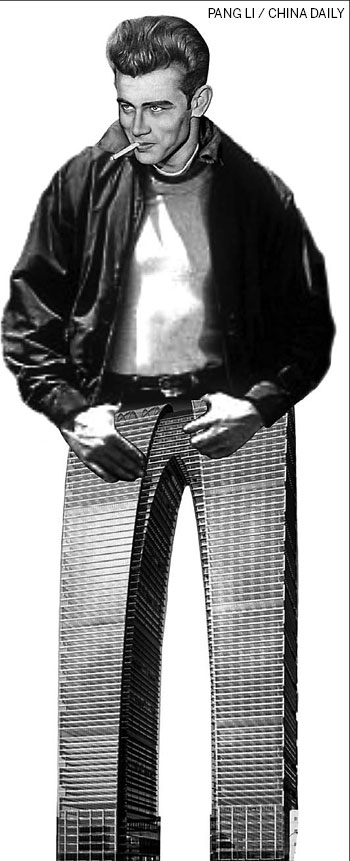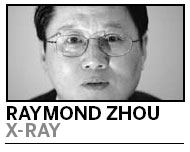Controversial constructions
Updated: 2012-09-15 07:49
By Raymond Zhou (China Daily)
|
||||||||

Populism in judging provocative architecture may attest to the pulse of public sentiment, but rarely does it foretell the fate of icon status.
Acluster of high-rises pierces Suzhou's skyline. Standing next to the Golden Rooster Lake, which anchors the bustling new downtown, will be 10 buildings. Two of these will shoot up 500 meters and connect at their top, forming an n-shaped twin tower that has spawned a spate of derision.
The cardinal sin, it seems, is the perceived resemblance with a pair of jeans. Some have joked that it would be appropriate if the Gate of the Orient, as the towers are officially known, becomes a hub for the garment industry, especially trouser producers. Others quip that the "Big Boxer Shorts", the nickname for the new CCTV tower in Beijing, would no longer be lonely with a newfound cousin in the south.
A healthy dose of sarcasm is good for expressing popular skepticism. But it would be a cheap shot for public intellectuals to jump on the bandwagon rather than probe the deeper causes for such reactions. Besides, how many of them have the specialized knowledge of architecture needed to offer educated opinions?
Of course, one does not have to be an expert to voice approval or disapproval. As China booms, there is no lack of outrageous structures that are anything but in harmony with their environments. There is a hotel not far from central Beijing that takes the shape of the ancient "immortals", a sort of Chinese magi with gaudy robes. The windows on the wall look like patterns on the robes.

We Chinese have a penchant for architectural styles that push to the extreme literal likenesses of physical objects, usually auspicious ones that symbolize wealth or good fortune. Structures with the contours of ancient coins or liquor bottles are unequivocal about what they stand for.
Another approach is to replicate existing landmarks. No, I'm not talking about theme parks with miniature models of world-class buildings. There are functional edifices modeled on the White House or the Tian'anmen Rostrum, and the owners are unabashedly proud of their shanzhai (copycat) attitude and aptitude.
Behind the raucous objection to the "jeans tower" lies a public vigilance against visual association that's too close for comfort.
But we need to differentiate between structures whose main purpose is to evoke the objects of designer's intention and those whose space for imagination is squeezed out by a dominant interpretation, often made in jest. The National Stadium did not intend to resemble a bird's nest, nor was the National Center for the Performing Arts meant to boil down its aspirations to the form of an egg. The similarity is more interpretative than intentional.
Another reason for the wave of antagonism toward the Suzhou tower is the absence of public feedback on such high-profile structures.
Whether public or private buildings, they tend to reshape the urban skyline, unlike villas that are tucked away from public view. A mechanism for public consultation will create a participatory milieu and proactively diffuse many of the bad feelings that may arise.
However, there is an artistic component to a potential landmark.
And, as such, a referendum on the design will only yield the lowest common denominator.
It is only natural that people are comfortable with architectural designs that are tried and true. In China or overseas, you never see a public protest against blandness and mediocrity. It is the "outrageous" buildings that are the targets of malcontent.
In hindsight, we all see many of these structures eventually become icons of the places where they were erected.
The Sydney Opera House is a well-known case in point. Now, it is the symbol of the city.
The Eiffel Tower was considered "useless and monstrous" in its day, and many of the biggest names in French arts and literature attempted to stop it from being constructed.
Likewise, calls to boycott the "giant egg" in Beijing were loud and clear. But since its 2007 opening, the eggshell of a theater has been wowing both spectators and patrons alike. No doubt it is on a fast track to becoming a new wonder in the ancient capital city's landscape.
If examined closely, "outrageous" buildings usually fall into two categories: extremely good or extremely bad.
They provoke your sensibility. Depending on your aesthetics, you'll either love or hate them.
But even if the majority of the current population demonstrates an aversion to it, by no means does it exclude the possibility that future generation may embrace it - or even exalt it to iconic stature.
China's urban planners are acutely aware of the power of architectural landmarks.
One building, smartly and presciently designed, may spread the reputation and even the spirit of a locale more efficiently than marketing campaigns of a massive scale. Think of Dubai's Burj al Arab and of all the advertising dollars it may have saved the country.
It's safe to say every Chinese city wants its equivalent of the Burj al Arab.
To achieve a higher likeliness of global fame, municipal officials have turned to international firms for designs. Almost all high-profile public projects in recent years, including Suzhou's Gate of the Orient, got their blueprints from big-name Western architects.
That decision may have ruffled some feathers among those who watch out for dubious foreign influences.
Some gripe that China has become a hotbed for architectural adventure. While it is premature to equate the quality of a design with the country where a firm or an architect is based, it leaves little doubt that these foreign conceptualizations tend to be unconventional.
Whether a building is bold and beautiful, or disputed and detestable, the experts may not be a bigger authority than the public - or vice versa. Will familiarity breed more complacency or more contempt? Only time will tell.
One thing is for sure, though: If all public buildings are subject to a citywide vote before getting the green light, few of the iconic structures that grace today's world would have jumped from the drawing board to the horizon.
The same goes for statues, installations, films, plays and operas. If anything, it shows that, when it comes to artistic matters, neither the size nor the education level of a crowd will certainly offer an inkling of what the future holds.
When China was just opening up in the 1980s, there was a fear that future skyscrapers would be built according to the "matchbox" template or with a high degree of uniformity in facade.
The fear was not unfounded. Only a decade earlier, the whole nation was dressed in the same colors - blue and gray - and the same sartorial configurations.
Given the Chinese proclivity for homogeny, we have turned out pretty well. If to err is human, I'd rather we err on the side of audacity.
I'd derive more gratification from a building that is annoying than one that is utterly forgettable.
Contact the writer at raymondzhou@chinadaily.com.cn.
(China Daily 09/15/2012 page11)

 'Taken 2' grabs movie box office crown
'Taken 2' grabs movie box office crown
 Rihanna's 'Diamonds' tops UK pop chart
Rihanna's 'Diamonds' tops UK pop chart
 Fans get look at vintage Rolling Stones
Fans get look at vintage Rolling Stones
 Celebrities attend Power of Women event
Celebrities attend Power of Women event
 Ang Lee breaks 'every rule' to make unlikely new Life of Pi film
Ang Lee breaks 'every rule' to make unlikely new Life of Pi film
 Rihanna almost thrown out of nightclub
Rihanna almost thrown out of nightclub
 'Dark Knight' wins weekend box office
'Dark Knight' wins weekend box office
 'Total Recall' stars gather in Beverly Hills
'Total Recall' stars gather in Beverly Hills
Most Viewed
Editor's Picks

|

|

|

|

|

|
Today's Top News
Health new priority for quake zone
Xi meets US top military officer
Japan's boats driven out of Diaoyu
China mulls online shopping legislation
Bird flu death toll rises to 22
Putin appoints new ambassador to China
Japanese ships blocked from Diaoyu Islands
Inspired by Guan, more Chinese pick up golf
US Weekly

|

|






